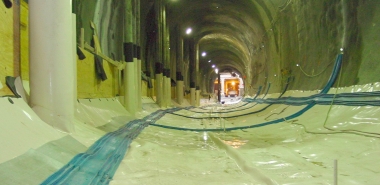Publications
Tunneling Under Dulles Airport
Tunneling Under Dulles Airport
RETC 2003
Rapid Excavation and Tunneling Conference - Proceedings 2003
Related projects
MBTA, Russia Wharf Segment, Section CC03A
The Russia Wharf segment is the last, but most challenging section of the Silverline Phase II construction for the Massachusetts Bay Transportation Authority (MBTA). The line is designed to provide a dualmode bus rapid transit connection between the central business district in South Boston to the new Convention Center. The tunnel passes diagonally under the 100 year old Russia Wharf complex, which comprises three seven-story buildings with steel frames and brick facades listed in the National Register of Historic Places.
Tottenham Court Road Station Upgrade Execution
The major upgrade to the LU Tottenham Court Road Station has been proposed to relieve congestion, achieve step-free access and modernise the station. The major elements of the station upgrade comprised a new enlarged sub-surface ticket hall, a fire-fighting access / emergency escape shaft linked to both Central and Northern lines, a triple escalator barrel, and concourses to the Northern and Central lines. In the latter concourse two new overbridges were included to lead to the platforms via new stairs and lifts.
You are here
Waterproofing & Water Control
Dr. Sauer & Partners promotes the use of flexible membranes for providing dry underground spaces. Underground structures are constantly moving. As they move, they develop strains due to earth loads, stress redistribution and tectonic and seismic influences, which may cause cracks to develop in the structure. If not waterproofed, the cracks can allow water to migrate into the structure and possibly damage utilities, interior finishes and even the structure itself.
Therefore a waterproofing system must be able to handle the strains and bridge the cracks in order to keep the structure dry. Fortunately, flexible membranes can fulfil these requirements and also have the advantage that the seams can be pressure tested during installation to ensure the integrity of the membrane.
There are two types of waterproofing systems; an ‘open’ and a ‘closed’ system. The ‘open’ system utilizes the waterproofing membrane to channel the water to a sidewall drain which must be cleaned and maintained on a regular basis. For structures below the groundwater level, the entire structure is wrapped with the waterproofing system creating a ‘closed system’.
In both systems a sectioning and control system is incorporated in order to detect and treat leaks locally. Both systems have been successfully installed in many tunnels and cut-and-cover stations and have provided clean, dry and safe structures.
The positive effect of the membrane waterproofing system on the durability of structures and the reduced maintenance costs have been acknowledged by the Federal Transit Administration (FTA) in their "Lessons Learned Program".


